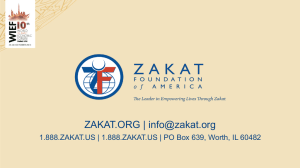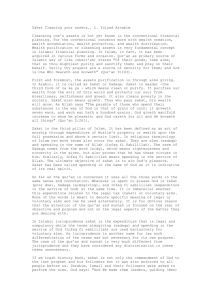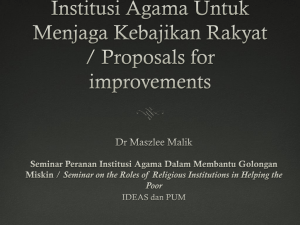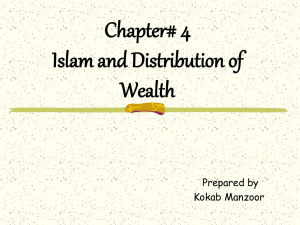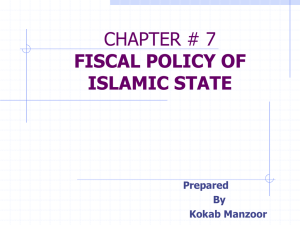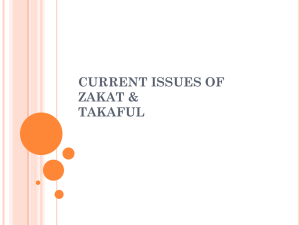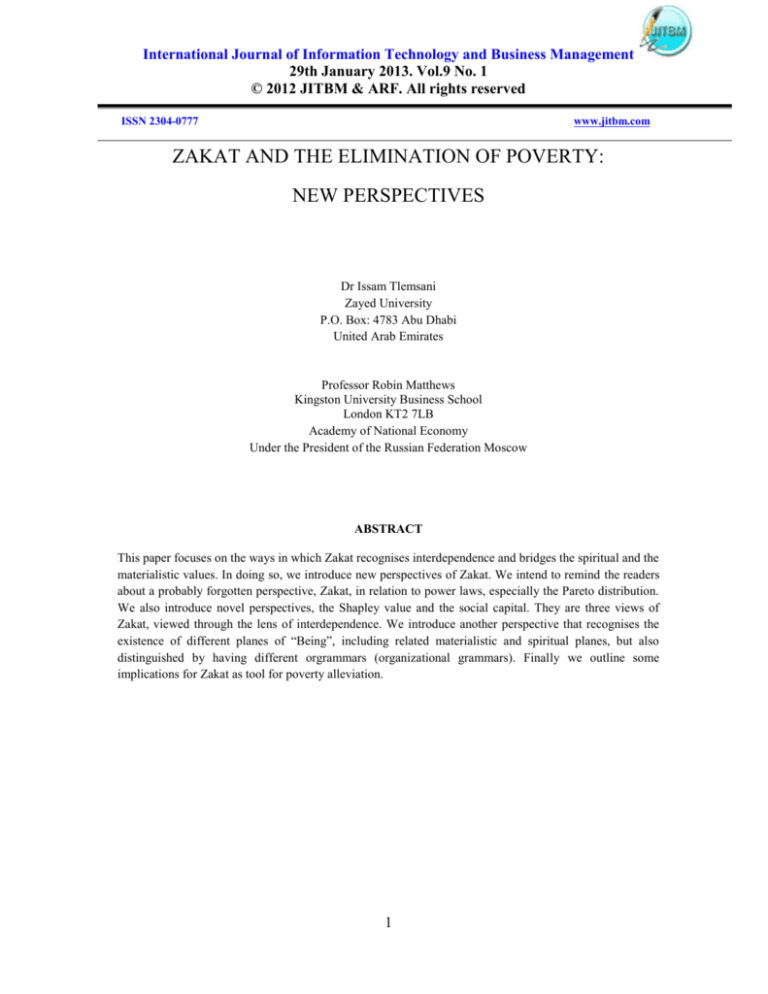
International Journal of Information Technology and Business Management
29th January 2013. Vol.9 No. 1
© 2012 JITBM & ARF. All rights reserved
ISSN 2304-0777
www.jitbm.com
ZAKAT AND THE ELIMINATION OF POVERTY:
NEW PERSPECTIVES
Dr Issam Tlemsani
Zayed University
P.O. Box: 4783 Abu Dhabi
United Arab Emirates
Professor Robin Matthews
Kingston University Business School
London KT2 7LB
Academy of National Economy
Under the President of the Russian Federation Moscow
ABSTRACT
This paper focuses on the ways in which Zakat recognises interdependence and bridges the spiritual and the
materialistic values. In doing so, we introduce new perspectives of Zakat. We intend to remind the readers
about a probably forgotten perspective, Zakat, in relation to power laws, especially the Pareto distribution.
We also introduce novel perspectives, the Shapley value and the social capital. They are three views of
Zakat, viewed through the lens of interdependence. We introduce another perspective that recognises the
existence of different planes of “Being”, including related materialistic and spiritual planes, but also
distinguished by having different orgrammars (organizational grammars). Finally we outline some
implications for Zakat as tool for poverty alleviation.
1
International Journal of Information Technology and Business Management
29th January 2013. Vol.9 No. 1
© 2012 JITBM & ARF. All rights reserved
ISSN 2304-0777
www.jitbm.com
Keywords: Zakat, Poverty, Shapley value, Dasein and Islamic Economy
I.
INTRODUCTION
Zakat, the alms-giving practice is one of the five pillars of Islam. It has a spiritual and a material
dimension. It is second only to prayer, and is an essential Article of Faith. Non-observance of Zakat is
tantamount to negation of Faith as evident from the following:
“Knowest thou not that prayer and the Zakat are complementary and the one is not accepted
without the other.” (Abu Bakr).
Zakat implies co-operation, interdependence and responsibility among the group/society. At a materialistic
level, it is intended to promote justice and prevent disruption. Spiritually, it places the giver and the
receiver on an equal footing. Islamic economics, in contrast to conventional economics, does not sharply
divide the economic and the spiritual values/ spiritual activities; this is reflected in Zakat. Under Sharia
law, payment of Zakat is a legal obligation, a tax on wealth. According to other legal systems, it is a
voluntary activity; however, it is a spiritual obligation. Calling Zakat a tax, voluntary or not, somewhat
distorts its meaning. Rather than a tax it is a gift that carries the blessings of the giver to the receiver.
Conventional economics tends to underestimate the importance of gift relationships by focussing on
individual behaviour. For example, an economics textbook usually begins with micro analysis of the
consumer, the household, the firm and the industry. On the contrary, macroeconomics proceeds to treat the
economy as an aggregate of atomistic units, striving for equilibrium, stability and growth, with
governments having higher or lower degrees of responsibility in these respects, depending on the stance of
the economist concerned. Non conventional economics and non conventional approaches, due to the
emergence of social and environmental issues, have started to intrude the conventional economics, taking a
wider perspective in recognising the obvious. For example, wealth and income do not equal happiness, as
relative income matters to individuals as much as absolute income. An individual’s contribution to the
society depends on the contribution of others. Co-operation is a source of social capital-a kind of gift to the
society. These examples illustrate the recognition of interdependence. Economics and ethics/moral conduct
are approaching closer to each other; however, for most parts the spiritual and materialistic values are quite
distinct.
In one sense Zakat is entirely pragmatic: it applies to the materialistic world, which we characterize in a
much similar way to Heidegger’s notion of Dasein. Dasein is a technical term that Heidegger used to
describe the manner of human existence. Immersed in the materialistic world of normal perception, nonthinking observers separate from it and are known as Descartes. The distinguishing feature of human
existence in Dasein is the awareness of the inevitability of death and impermanence. Our first three
perspectives relate primarily to Dasein.
As a Pillar of Islam, Zakat spans Dasein and the spiritual worlds, which are not acknowledged in
Heidegger’s scheme. The distributional function of Zakat, i.e., ownership of wealth and entitlement to
income are inter-wined with a spiritual and symbolic function of cleansing, fana. Fana is a technical term
from Sufism, meaning annihilation of the self. The distinguishing feature of the two worlds is our fourth
perspective. Different worlds have different orgrammars. In our terms, the stages of fana refer to the
transition from one orgrammar to another.
2
International Journal of Information Technology and Business Management
29th January 2013. Vol.9 No. 1
© 2012 JITBM & ARF. All rights reserved
ISSN 2304-0777
II.
www.jitbm.com
NEW PERSPECTIVES
This section summarizes the relationship of Zakat with the perspectives of (i) social capital, (ii) Shapley
values, (iii) power laws, and (iv) orgrammar, as illustrated in Figure 1.
Orgrammar
(organizational grammar)
Social capital
Zakat
Shapely Values
Power laws
(i)
Zakat and social capital
Social capital refers to trust and concern for one’s associates and the willingness to live by the norms of
one’s community. Zakat serves as the source of trust, recognising interdependence of the community,
benefiting the giver and the receiver. There are various types of capitals namely, physical, human and
social capital. In the terminology of game theory, capital is a source that emanates the flow of payoffs,
monetary objects and non–monetary objects that can be distributed in various ways. Zakat is a source of
social capital having spiritual and material dimensions. Its purpose is to prevent the exploitation of society
by alleviating poverty and inequality. The foundation of Zakat reflects (a) the understanding that wealth
and income are merely leased to a person by God and (b) the implication that spiritual and material values
flow from it, reciprocally from the giver to the receiver. Differences in wealth and income are inevitable
but severe differences and poverty can be disruptive and cause breakdown of societies. In such
circumstances, religious and humanistic traditions acknowledge the necessity of almsgiving and generosity.
Stretching the notion of capital to other planes of Being (existence), Zakat intends to be a source of spiritual
purification. Ibn Taymiyya (1328) states that,
3
International Journal of Information Technology and Business Management
29th January 2013. Vol.9 No. 1
© 2012 JITBM & ARF. All rights reserved
ISSN 2304-0777
www.jitbm.com
“The inner soul of the Zakat payer becomes better, and his wealth becomes cleansed.” i "Take Zakat from
their wealth to purify and cleanse them.”ii Al-Azhari says, “It makes the poor grow too”.
(ii)
Zakat and Shapley values
The Shapley value was proposed by Lloyd Shapley in 1950 as a concept for solution of co-operative
games. Games are called co-operative if commitments, including formal rules, informal rules, traditions
and agreements are binding. Co-operative games were pioneered by Neumann and Morgenstern (1944).
Solution concept means, if all members (or players) of a society (or game) receive payoffs according to
their Shapley value, it exactly equals the total payoffs, i.e., the sum total of Shapley values equals the value
(total payoffs) of the game.
The central idea of the Shapley value is that society is made up of teams or coalitions that create (or
destroy) value. Any individual is a member of many coalitions or teams, such as families or organizations
in which he/she works voluntarily or in paid employment, neighbourhoods or communities in which he/she
lives, mosques, churches or charities that extend to entire societies and so on. The term coalition describes
these diverse groups.
According to Shapley, the contribution that an individual generally makes to a society is the (weighted)
sum of the contributions (the differences) he/she makes to all the coalitions he/she is a member of. Shapely
showed that all individual contributions, suitably weighted, added up to the total value created by the
society.
The Shapley value illustrates the interdependence perspective of Zakat. Payoffs apply equally to both
givers and receivers. They are formed by individuals who willingly co-operate in a society rather than
atomistic individuals who act independently of one another. Zakat represents the recognition that society
needs to be co-operative rather than individualistic. People co-operate in groups or societies to create value.
The Shapley value illustrates that (c) gains from co-operation are the rationale for living in a society and (d)
one person’s contribution is dependent on another’s contribution.
(iii)
Zakat and power laws
Power laws describe the frequently observed characteristics of life. An inverse relation exists between the
large and small events; large events are rare and small events are common. For example, (i) there are few
large earthquakes and many small ones; (ii) a few words like the, and, a, but, are used often, whereas many
others are used rarely; (iii) a small number of websites receive millions of billions of hits from internet
users whereas many other websites receive a few hits; (iv) many firms have few employees, and few other
firms have many employees, etc. The power law describes an inverse relationship between variables x and
y mathematically as
y
kx
, where, y is one variable (e.g., number of sites), x is another variable
(e.g., number of hits), k is a constant, the power law exponent, and
denotes an approximate
relationship. In special cases of power laws such as Zipf’s law, the exponent 1. Pareto distribution,
sometimes called the 80:20 rule, is also a special case of inverse power law relation, where, is
approximately 2 (varies between 1.5 and 3). We use the Pareto law in connection with income and wealth
distribution, and Zakat because both formalise the inequality and are a benchmark of distribution. Power
laws are fat tailed distributions; they illustrate a fact that though extreme events are rare, they happen much
more frequently than expected under a normal (Gaussian) distribution. Inequality and injustice can trigger
4
International Journal of Information Technology and Business Management
29th January 2013. Vol.9 No. 1
© 2012 JITBM & ARF. All rights reserved
ISSN 2304-0777
www.jitbm.com
disruptive events; for example, the recent events in the Middle East had dominating effects because the
underlying power laws were the fact of interdependence.
Zakat, seen from the perspective of power laws, illustrates (e) the inevitability of inequality and injustice,
and (f) that extreme events, sometimes resulting from (d) are inevitable.
(iv)
Zakat and Orgrammar
Different planes/spheres of Being have their different orgrammars. The scriptures span different
orgrammars, referring to laws that regulate or guide behaviour towards God, one another and purely
spiritual experiences and insights. Zakat spans the material and the spiritual worlds. The most immediate
orgrammars relate to the world of experience: the material world that includes business and political
organizations and institutions, social institutions, communities, organizations and minds of people.
Heidegger’s concept of Daseiniii describes the world of experience. The planes or spheres of Being
extended beyond Dasein even though connected to Dasein, are connected to each otheriv. The orgrammars
exist in a hierarchy, corresponding to different planes of Being, with many, often overlapping orgrammars
in each plane. We can assume orgrammars as having lateral/horizontal dimensions, indicating the fact that
there are many alternative grammars pertaining to each sphere of Being. There are many spaces, relating to
different planes or spheres of Being, each having a distinctive orgrammar. Thus, spheres of Being and
related orgrammars have a vertical dimension, described metaphorically in various ways; the material
world, the worlds of the soul, the spirit, etc are some descriptions.
In spanning spiritual and material dimensions, Zakat spans the different planes of Being and their
associated orgrammars or organizational grammars, similarly to the scriptures. Whilst grammar by
Wittgensteinv describes the rules for the use of words, Orgrammars is broadly described as organizing
principles that introduce orders and enable us to make sense of the entire system on material or spiritual
planes.
III.
CONTEXT AND FURTHER ANALYSIS
All religions and mystical traditions seem to be divided into two related activities, practice (Muamalat) and
spirituality (Ibadat). This is also the case with Zakat. This section throws more light on the perspectives of
Zakat that were outlined in the previous section. The perspectives overlap, but for convenience we divided
them into four groups as illustrated in Figure 1.
The first group relates to the power law perspective of reducing the socio-economic gap and social
insurance. The second group relates to the Shapley value perspective of co-operation and justice. The third
group relates to investment and social capital. The fourth group defines Zakat as a bridge between the
spiritual and the material world and the idea of orgrammar.
i.
Zakat, the socio economic and social insurance; power laws
Zakat aims for reducing the socio-economic differences by distributing wealth and income. ‘Whatever
booty Allah gives to his messengers from city dwellers belongs to Allah, the messengers, his near relatives,
orphans, the poor and the travellers, so that it does not become something, which merely circulates among
the rich and you.’vi This is the cornerstone of social insurance. Mutual social care in Islamic society
5
International Journal of Information Technology and Business Management
29th January 2013. Vol.9 No. 1
© 2012 JITBM & ARF. All rights reserved
ISSN 2304-0777
www.jitbm.com
extends to all branches of human life. Like other religions, there are two categories of almsgiving in Islam:
Zakat, which is prescribed by law (corresponding to the tithe in Christianity) and voluntary gifts or
Sadakat. Under Islam, every believer is obligated, as a religious duty, to give one tenth of his annual
revenues to support the poor.
The question raised here concerns how Zakat, as an obligation, relates to the power law distribution, and in
particular how does it relate to the Pareto distribution. There are two aspects of the question. The first
relates to distribution itself and the second relates to the widely issue of how power laws seem to express
surprising regularities in nature. Here the subject matter is economics and income distribution (the
association of power laws with extreme events like social revolutions and transformation of entire societies,
for the better or worse, as for example, the current upheavals in the Middle East). Here we focus on the
first aspect as it most closely relates Zakat with the Pareto distribution; wealth, income, poverty and Zakat.
In a sustainable community ( a community that is not trapped in any famine or war), with stable or growing
income or wealth, the sum of those incomes that exceed the agreed subsistence level must be greater or
equal to the sum of those below it. Denoting the total number of people in a society as N (substituting N for
k in inverse power law relation), we have
y Nx
Figure 2 depicts the above equation.
Income
(y)
M
T
A
B
S
Subsistence income
A*
G
U
0
½N
6
N
Number of
people (x)
International Journal of Information Technology and Business Management
29th January 2013. Vol.9 No. 1
© 2012 JITBM & ARF. All rights reserved
ISSN 2304-0777
www.jitbm.com
Figure 2 shows the curve TSU, the density function, as income distribution among the population N. The
distance between ½ N and N means that exactly half of the population is below subsistence income. The
incomes of the poor are assumed to be distributed linearly (indicated by the straight line section SU). The
other half are above subsistence level (indicated by the curved line section TS). Let the area A is assumed
equal to area A* on the graph, i.e., area TMS= area SGU). If we assume area A as Zakat, for bringing the
poor up to subsistence level income, then the remaining area B (indicated by MBS) is the excess income of
the upper income groups that can be used for the accumulation of capital and wealth in the future.
ii.
Zakat, co-operation and Shapley values
A natural effect of the concept of universal brotherhood, in principle, is mutual co-operation and help.
According to the Holy Prophet:
“Mankind is the family of God and the most beloved of them before him is one who is the best to
his family….Be kind to those on earth and He who is in Heaven will be kind to you” vii.
As religion considers mankind as one family, all its members are alike in the eyes of God and before the
law He has revealed. The criterion of worth according to the statements of the Holy Prophet is:
“Certainly God looks not at your face nor your wealth: instead he looks at your heart and you deeds”.viii “O
mankind! We created you from a male and a female and made you into nations and tribes that you may
know each other. Verily, the most honored of you before God is the most righteous of you; surely God is
knowing, aware”ix. The Qur’an states, “say O mankind! Surely I am a messenger of God to you all “ x and
the Holy Prophet said, “I have been sent to all alike, the red or the black”xi.
Distributive justice within Islamic society does allow differences in earnings as long as they obey the
differences between the values of the service one contributes to society as a whole. Justice does not
necessitate everyone to be regarded equally, irrespective of his contribution to society, but in an
interdependent society one’s contribution is often dependent on the contribution of others. This is implied
by the Shapley value, which differs fundamentally from the conventional economic lens through which
distribution is viewed.
a)
Marginal Productivity Theory
The analysis of factor payment (for e.g. wages) through marginal productivity is determined by the
worker’s marginal revenue product; the contribution he/she makes to the value of the firm through his/her
sole effort. Other factors like capital, determine the position of the marginal revenue product curve and the
profit maximizing firms attempt to equate the marginal revenue product with the wage rate. This, together
with the supply of labour, determines employment. Not focusing on other aspects of the model (for e.g. the
degree of monopoly, whether firms maximize or not), the Shapley value tells a different story.
According to the Shapley value story, society is made up of activities and social groups or coalitions. If
there are N numbers of activities in a society, there are 2N coalitions that any individual can be a member
of. The Shapley value then considers the marginal contribution, i.e., the difference that an individual makes
to the value of a coalition by being a member of it. The Shapley value is the weighted average of those
7
International Journal of Information Technology and Business Management
29th January 2013. Vol.9 No. 1
© 2012 JITBM & ARF. All rights reserved
ISSN 2304-0777
www.jitbm.com
marginal contributions. If we suppose every coalition to be likely equal, then the weights are given as the
probability of that coalition occurring.1
iii.
Zakat commercial investment and social capita
Most Muslim countries are characterized by a low per capita income; an unduly large subsistence sector,
high population pressure, low agricultural productivity, exploitation of resources, a high rate of
unemployment, scarcity of skills and weak institutional and physical infrastructure. Hence, innovative
approaches need to be explored for finance and investment. Kawachi et al. (1999) relate social capital to
mortality rates and inequality. They also suggest that the large gap between the rich and the poor leads to a
breakdown in social cohesion and the homicide rate.
The Shapley approach looks at Zakat from the distributional point of view. Let us take an alternative
perspective, implicit in the Quran, of seeing Zakat as bestowing benefits on both the giver and the receiver.
In that case, instead of seeing excess income (area A) compensating for the deficient income (area A*), we
should add the two areas (A + A*), bestowing payoffs on givers and receivers reciprocally. Also the two
areas constitute a flow of payoffs emanating from a source, social capital.
Zakat sets out rules for the distribution of payoffs from money/wealth. This is perhaps the least important
aspect of Zakat. In a perfect system, equitable distribution can be decentralised without the need to incur
the costs of state intervention and welfare: it would be achieved voluntarily. Human nature rarely conforms
to such an ideal, but, the existence of Zakat plus a degree of voluntarism goes a considerable way in
reducing the costs of creating greater fairness: an important function of social capital. Failures of global
capitalism, especially those emanating from the financial sector, are endemic. Governments and
international institutions, like the World Bank and International Monetary Fund, are not solely accountable
to correct all market failures2. Social capital is a schema that underlies the development of business systems
including their norms and behavior. Without it, market systems cannot flourish because transaction costs
would soar in the absence of rudimentary trust. In the global sphere, social capital is relatively
underdeveloped, but, the sense of international responsibility is growing.
1
The Shapley value of an activity s (s = 1, 2 ...K) is
s
S !( K S 1)!
BK / s BK In the equation s denotes the Shapley value of individual s.
K!
S K s
S is the size of the coalition in questions (S = 1, 2…K.
individual s is part of it.
BK / s denotes the value of the coalition when
BK denotes the value of the coalition without individual s. So the last term
expressed what the individual adds to a particular coalition; the first term after the equality sign denotes the
probability of the coalition occurring if all coalitions are equally likely. The exclamation mark! denotes K
factorial and so on. If K for example is 4 (4! = 4x3x2x1). So K =4 and S =3, the first expression after the
equality sign (the weight) is.
3!(4 3 1)! 3!(0)! 3!1! 1
i.e. there is only one way in which a
4!
4!
4! 4
fourth person can be marginal to a coalition of three if there are only four persons to start with. S = 1, 2, 3)
we would have a complete set of weights.
2 Brenner (2002), Stiglitz and Soros (2003).
8
International Journal of Information Technology and Business Management
29th January 2013. Vol.9 No. 1
© 2012 JITBM & ARF. All rights reserved
ISSN 2304-0777
www.jitbm.com
Coleman (1998) suggests that the most useful relationships between individuals act as a form of social
insurance: they provide communication, information networks and create the norms and sanctions that
facilitate social action. He distinguishes three relationships: (a) obligations, expectations and
trustworthiness expressed in structures and norms, (b) effective sanctions and (c) information channels. 3
The first two correspond quite closely to the understanding of Zakat in Islam.
Putnam (1993) says that norms and trust are the source of social capital in which people learn to do the
right thing from the society’s point of view; developing a sense of shared destiny. There can also be an
emotional element of social capital: commitment to a cause and caring for others are also sources of
payoffs, both monetary and non monetary. Social capital and Zakat are sources of flow of payoffs, material,
emotional and spiritual that benefits the body and soul. Ibn Taymiyya (1328) quotes from the Qur’an;
"Take zakat from their wealth to purify and cleanse them”.4
Returning to an interpretation of Zakat, as money adds to a potential source of investable funds, area A in
Figure 2 is assumed to exceeds A* (MTS > SGU). Proposals to channelize Zakat funds into long-term
investments, in order to accelerate the pace of development in Muslim countries, break the fresh ground of
Zakat utilization strategy. This consideration is especially relevant for the annual dispensation of Zakat;
beneficiaries receive sufficient Zakat to cover their expenses for the entire year. Although Zakat is
received annually, expenditures carry on throughout the year, meaning that money can be left idle.
Till now, lawmakers hesitate to permit investment of Zakat funds, not because there is anything in the
Qur’an which explicitly or implicitly precludes such investment, but because of the fear of loss. They do
not facilitate fulfilling the immediate consumption needs of the poor. Is it permissible to invest Zakat
funds? Accumulated Zakat funds can lie unused. The crucial principle of self help also exists here, and we
should therefore remember that the Holy Prophet encourages a needy person to buy an axe to cut wood
instead of just helping him to meet his immediate requirements5. Keeping idle funds is in violation of the
Sharia, which is against hoarding, and in favour of a wide circulation for funds. Zakat inflows from its
donors and outflows to its beneficiaries.
In a Haddith6, the Prophet urged those who were responsible for managing the wealth of orphans to invest
that wealth in profitable ventures so that it would not suffer gradual erosion due to the Zakat on it. A Zakat
fund has a similar status for those orphans’ wealth, because in both cases the managers of the properties are
mere trustees of the stipulated beneficiaries.
IV.
ORGRAMMAR AND ZAKAT: BRIDGING THE MATERIAL AND THE SPIRITUAL
WORLDS
3 Gintis and Bowles (2000) emphasize punishment, in their definition of social capital as referring to it as
‘trust, concern for one’s associates and willingness to live by the norms of one’s community and to punish
those who do not’.
4
The holy Qur’an 9:103.
5
Chapra, Umer
6
See end note 10
9
International Journal of Information Technology and Business Management
29th January 2013. Vol.9 No. 1
© 2012 JITBM & ARF. All rights reserved
ISSN 2304-0777
www.jitbm.com
Zakat bridges the spiritual and the material realms or planes of Being. Planes of Being are distinguished by
having different orgrammars. We can think of orgrammars as having lateral or horizontal dimensions,
indicating that there are many alternative grammars pertaining to each sphere of Being. The process of
deconstruction might be described as that of unveiling or discovering alternative grammars in Dasein.
a) Zakat in Dasein
First, we focus on the plane of Being that people insist upon calling the real world; loosely speaking, the
real world is the world we are a part of in everyday experience, which Heidegger called Dasein. The
dominant orgrammar conditions the way the real world or plane of Being (Dasein) behaves and conditions
the way it is perceived along with the criteria on which it is evaluated. The dimensions of orgrammar are
formed by, (a) formal or informal, (b) social or personal (c) internal or external set of rules operating on
society and on organizations and determining their state. We add two further dimensions which relate
directly to perceptions, (d) conscious/unconscious. The space occupied by orgrammar, even when we limit
discussion to Dasein, has a very high, perhaps infinite dimension 7.
F: formal
S: social
C: conscious
M: internal
X: external
U: unconscious
P: personal
I: informal
Figure 3: Orgrammar
7
Even figure 2, limited as it is, there are 4072, (210) possible groupings
10
International Journal of Information Technology and Business Management
29th January 2013. Vol.9 No. 1
© 2012 JITBM & ARF. All rights reserved
ISSN 2304-0777
www.jitbm.com
Table 1: Dasein’s Orgrammar Categorizes
11
International Journal of Information Technology and Business Management
29th January 2013. Vol.9 No. 1
© 2012 JITBM & ARF. All rights reserved
ISSN 2304-0777
www.jitbm.com
F S X
Formal
Social
External
Outside: societal, codified, written: laws, regulations, treaties,
contracts, rituals, traditions, constitutions.
F S M
Formal
Social
Internal
Inside: codified, written: formal organizational routines,
architectures, structures, systems, hierarchies, contracts
within.
F P X
Formal
Personal
External
Outside: codified, certified, accredited: formal education, shared
paradigms and ways of thinking, qualifications.
F P M
Formal
Personal
Internal
Inside: individual education and experience, certified, codified,
corporate: specific education, accredited skills, training and
knowledge.
I S X
Informal
Social
External
Outside: societal, group; informal (unwritten)
conventions, mores, morals, cultures, codes.
I S M
Informal
Social
Internal
Inside; societal group norms: shared values; corporate culture,
customs, traditions, mores, codes.
I P X
Informal
Personal
External
Outside: individual, un-codified: personal history and values,
behaviour, patterns, learned paradigms, mental maps, models,
conditioning, habits of thought.
I P M
Informal
Personal
Internal
Inside: As (IPX) individual behaviour patterns and mindsets,
personal paradigms and schema for assessing the world, and
solving problems; learned within the organization or the
personal legacy of brought in.
customs,
Table 1 categorizes the orgrammar of Dasein, according to Figure 3. The categories through FSX to IFM
are neither distinct nor exhaustive.
The principles of Zakat span the spiritual worlds, which we have designated as Dasein and the material
worlds. The scriptures span orgrammars across many planes of Being. Zakat, as part of Islamic scripture,
illustrates the bridging of orgrammars. The principles underlying Zakat in respect of the plane or sphere of
Dasein are: (i) economic justice and basic principles of taxation (ii) ease of collection (iii) convenience and
predictability of payments.
(i)
Economic justice
The concept of brotherhood implies equal treatment in society and before the law. The Qur’an urges
Muslims ‘Not to withhold things that are due to others’xii. This implies that every individual must get what
is due to him, but at the same time he should not deprive others of their share. This warning against
injustice and exploitation was designed to protect the rights of all individuals in the society, regardless of
whether they are consumers, producers, or distributors and to promote the general welfare. The Qur’an
states in Al-Baqara:
“And be constant in prayer, and render the purifying dues; for, whatever good deed you send
ahead for your own selves, you shall find it with God: behold, God sees all that you do”.
12
International Journal of Information Technology and Business Management
29th January 2013. Vol.9 No. 1
© 2012 JITBM & ARF. All rights reserved
ISSN 2304-0777
www.jitbm.com
Islam’s commitment to brotherhood, economic justice, gross inequalities of income and wealth are
contradictory to its spirit. They destroy rather than fostering the feelings of brotherhood. The
redistribution programme in Islam has three parts: (i) the teachings imply the rendering of assistance, by
those who are working, in finding gainful employment; (ii) it emphasizes the payment of Zakat for
redistribution of income from the rich to the poor, who because of personal disability, handicaps or any
other external conditions, are unable to attain a respectable standard of living by their own efforts. In the
words of the Quran: ‘wealth does not circulate only among your rich’xiii (iii) the estate of a deceased
person is divided, in accordance with a given formula, among a number of individuals in order to intensify
and accelerate the distribution of wealth in society.
(ii)
Ease of collection
According to the principle of economy in taxation, collection costs must be kept at a minimum. These
costs include what the state pays - such as collectors’ salaries and administrative and transportation costs.
Zakat, in principle, must be spent in the same locality in which it is collected to economize transportation
costs. Zakat officers occasionally return with no residual funds since they distribute all proceeds in the
same area from where they had collected it.
(iv)
Convenience and predictability of payments
Stability of the taxation system, like stability of business law, helps to build confidence and prosperity. The
basics of Zakat are fixed: knowing them is obligatory for every Muslim. Convenience, according to Smith
(1976), means that the tax and its collection procedures must be made convenient to tax payers, so that they
give the tax with pleasure and satisfaction, or at least without doubt or inconvenience. The Holy Prophet’s
instructions command taking Zakat out of the average quality of Zakatable assets and not the best of them.
In his instructions to Mu’adh, he says, ‘Avoid the best of their wealth’. The Holy Prophet instructs the
estimators of Zakat on agriculture to be moderate and to estimate on the lower side. He even orders them
to make allowances for errors and for the fruits used for family and charity. Zakat payment may be deferred
if necessary, whether for individual or general reasons, like Umar’s delay of Zakat in the year of the
general famine.
b)
Spiritual dimensions
The Freudian conscious, unconscious, plus the Jungian collective unconscious; as described in the Bardo
Thodol (below), is a vertical dimension of the spheres of Being and related orgrammars. Alternatively
spheres of Being, may be distinguished by simply saying that ethics and norms occupy a different space
from factual descriptions or the worldxiv.
In Figure 4, the horizontal and vertical dimensions of orgrammar are collapsed into two dimensions:
perhaps from the infinite alternative grammars gi, 5 orgrammars are illustrated. The set of all orgrammars is
denoted as G. Individual orgrammars have elements in common; for example g5 has overlapping
characteristics with g2. Perhaps all orgrammars have some characteristics in common, as illustrated by the
intersection (
i
gi )
of the 5 orgrammars. The 5 grammars, illustrated, do have distinctive features,
(indicated by g1, g2,...., g5). The relationship between grammars signifies (family) resemblance rather than
distinctiveness (disjointedness).
13
International Journal of Information Technology and Business Management
29th January 2013. Vol.9 No. 1
© 2012 JITBM & ARF. All rights reserved
ISSN 2304-0777
www.jitbm.com
Figure 4
G i gi
g3
i
g2
gi
i gi
g1
g5 ∩ g2
g4
g5
V
CONCLUDING REMARKS
In the preceding sections, we have limited many possible perspectives of Zakat only to four. We chose a
power law perspective because the Pareto distribution, a special case of power laws, summarizes empirical
distributions of wealth and income between the nations and within them. We also chose it because power
laws specifically incorporate the possibility of positive feedbacks, or as they are more commonly known,
domino effects; the possibility of extreme events spreading like viruses, often form small beginnings, to
engulf states and governments in turmoil, either for better or worse conditions. Extreme events, revolutions,
tsunamis, financial crises, and terrorism no longer seem as remote, as they are imagined under conventional
thinking of normal distribution
We chose the Shapley value perspective because not only it illustrates the independence of one person’s
contribution upon that of others (in different occupations, different states and from different social classes),
but also illustrates the observation that justice requires that we recognise interdependent contributions
explicitly by addressing questions of inequality, injustice and poverty.
The case for considering institutionalized almsgiving as a form of social capital is inescapable. The social
capital aspect of Zakat is also tied with two of our previous perspectives; giving redistributes wealth and
income, and doing so dilutes inequality, injustice and poverty, which partly are sources of extremism.
Further, increase of social capital depends on the kinds of investment in co-operation and reward systems,
implied by the Shapley interpretation of contributions to society.
Considering the fourth perspective, we should be very cautious while speaking about the spiritual capital;
doing so would be to interpret the spirituality in the orgrammar of Dasein: the opportunistic and greedy
14
International Journal of Information Technology and Business Management
29th January 2013. Vol.9 No. 1
© 2012 JITBM & ARF. All rights reserved
ISSN 2304-0777
www.jitbm.com
version of Dasein that pervades a much corporate behaviour and is rationalised in universities across the
world, especially in business schools.
The orgrammar perspective eludes many commentators on religion, who insist on interpreting the mystery
of the scriptures from a narrow positive viewpoint to a pseudo-scientific viewpoint; pseudo scientific
because developments in many sciences reveal the existence of mystery: knowledge as a kind of infinite
cave that can and should be explored without end, and always remains endless.
Seeing Islamic and Western traditions as opposite poles is like ignoring their co-evolutionary past. The
influence of Islam on the West, founded on trade was, in fact, strengthened by the crusades. The two
societies were influenced by co-migration. European notions of Chivalry, Courtly Love and Romanticism
had emanated from Islam in the twelfth century. Dante’s poetry also drew deeply from the Qur’an. Islamic
states have been influenced by Western economics and politics, through imperialism; the discovery of oil
and natural resources in the Middle East and North Africa. Europe has got sizeable indigenous Muslim
population. Muslim students, poets, writers and scholars have been deeply influenced by Western
Education. Middle Eastern wealth is deposited in Western industrial companies and financial institutions. It
is hardly surprising that common traditions and values should exist: more surprising that they have been
overlooked. The legal traditions of Islam and the West emanate from different sources: Sharia and Roman
law: however, when we compare the three religions of the book, Judaism, Christianity and Islam, we see
that their respective messages coincide substantially.
One of the reasons for choosing our four perspectives was to show that concepts from modern economics
and philosophy form a part of alternative economics which is neither entirely Islamic nor entirely market
capitalist or socialistic, but is a synthesis. Of the four perspectives, the fourth (recognition of many
orgrammars), is perhaps the most significant. It suggests that the spiritual and the material worlds are
inseparable; however, it is their appropriate grammars that differ.
The significance of the Zakat act can perhaps only be realised through poetic language or the language of
mysticism. The instrumental aspects of Zakat suggest that paying Zakat is an act of spiritualism and
materialism: a kind of spirituality that is designed to produce payoffs. If someone gives Zakat according to
the principle of spiritualism and materialism, he/she is benefitted spiritually. Then he/she, in a sense, gives
nothing; considering the injunction present in most religions; not to let others know when good deeds are
performed by oneself.
The inner meaning of Zakat is associated with knowledge, expressed mystically, by the observation - ‘Man
is asleep, and wakes up only at death’ and the injunction to fana - ‘die before you die’: to die in one plane
of understanding or orgrammar before another plane is possible.
REFERENCES
Bernner, R. (2002) Force of Finance: Triumph of the Capital Markets, Texere.
Chapra, U. (2000) The Future of Economics: An Islamic Perspective, UK, The Islamic Foundation Press.
Coleman, S. (1998) ‘Social Capital in the Creation of Human Capital’, American journal of sociology, 94,
S95-S120.
Gintis. H. and Bowles, S. (2000) Social Capital and Community Governance, Amherst, Massachusetts.
Heidegger, M. (1996) Being and Time: A Translation of Sein and Zeit (SUNY series in Contemporary
Continental Philosophy, State University of New York.
15
International Journal of Information Technology and Business Management
29th January 2013. Vol.9 No. 1
© 2012 JITBM & ARF. All rights reserved
ISSN 2304-0777
www.jitbm.com
Kawachi, I., Kennedy, B. P. and Wilkinson, R. G. (1999) ‘Crime: Social Disorganization and Relative
Deprivation’, Social Science and Medicine, 48,719-731.
Matthews, R. (2011) ‘Organizational Grammar, Godel and the Other’, Journal of Organizational change
Management, Forthcoming.
Matthews, R. (2003) Sufi Contemplation And Management: Latifas As Centres Of Consciousness. In A.
Alkafaji and J. Biberman, Ed. Business Research Yearbook, Vol IX.
Mauss, M. (2000) The Gift: The Form and Reason for Exchange in Archaic Societies, USA, W. W. Norton
& Company.
Neumann, J. and Morgenstern, O. (1944) Theory of Games and Economic Behavior, Princeton: Princeton
University Press.
Putnam, D. (1993) Making Democracy Work: Civic Traditions In Modern Italy. Princeton: Princeton
University Press.
Shapley, L. (1953) In Contributions to the Theory of Games volume II, H.W. Kuhn and A.W. Tucker
(eds.).
Smith, A. (1976) The Wealth of Nations edited by R.H. Campbell and A.S. Skinner, The Glasgow edition
of the Works and Correspondence of Adam Smith, vol. 2a, p. 456. UK.
Soros, G. (2003) The Alchemy of Finance: The New Paradigm, John Wiley and Sons Inc.
Stiglitz, J. E. (2003) Globalization and its Discontents, Penguin Books.
i
The collection of fatwa sheikh al-Islam Ibn Taymiyya, col. 25, p.8.
The holy Qur’an 9:103.
iii
Heidegger (1996); Dreyfus (1999). Dasein means literally being-here or being-there. The implication of
choosing Dasein to describe the real world is that there is no separate intending subject (decision maker)
deciding what to do; instead the subject is part of the world, inseparable from the world whose decisions
are governed by the prevailing orgrammar or orgrammars. Heidegger’s Dasein corresponds to the Buddhist
notion of attachment; (WO) man’s behavior is programmed/conditioned by properties of orgrammar. This
view is completely at variance with the stance taken by many economists and most academics in business
schools (particularly strategists); in which rational subjects make decisions about a separate (predicate)
world. Where Heidegger’s view differs from that of contemporary cognitive science is in the possibility of
living authentically; that is, being distinct from the crowd by being conscious of the predicament of death.
Heidegger’s limitation is that he seems to perceive that there is only a single sphere of Being. However
authenticity in is surely a kind of meta cognition. See later comments, on the Bardo Thodal, on the absence
of orgrammar nothingness and death.
iv
The idea of interconnectedness of different spheres of Being is what Jung was trying to capture with his
concept of synchronicity, and Swedenborg with the concept of correspondences.
v
Wittgenstein (1953); Forster (2004); Lyotard (1979).
vi
The holy Qur’an 59:7.
vii
Chapra.M. “The economic system of Islam” Oxford press, Lahore, 1970
viii
ibid page 11.
ix
The holy Qur’an 49:13
x
The holy Qur’an 9:11
xi
Chapra.M. “The economic system of Islam” Oxford press, Lahore, 1970
xii
ibid page 11.
xiii
The holy Qur’an 59:7.
xiv
Swedenborg wrote of correspondences between different spheres of Being in the scriptures;
distinguishing divine, spiritual and mundane level: expressed in our terms each sphere has its own
orgrammar. Jung expressed the same idea as synchronicity.
ii
16

